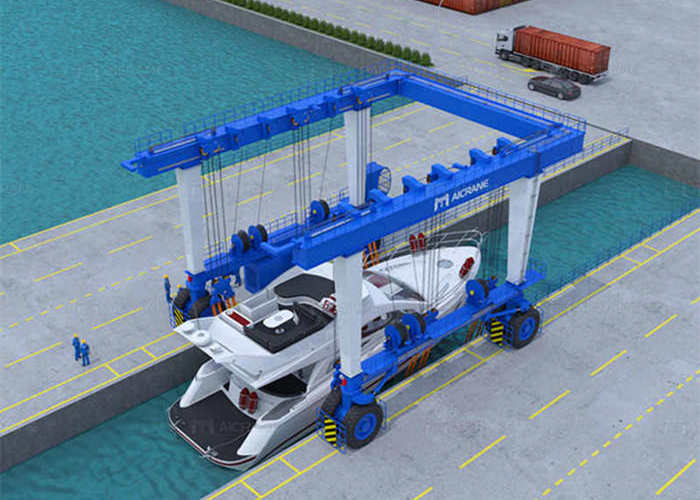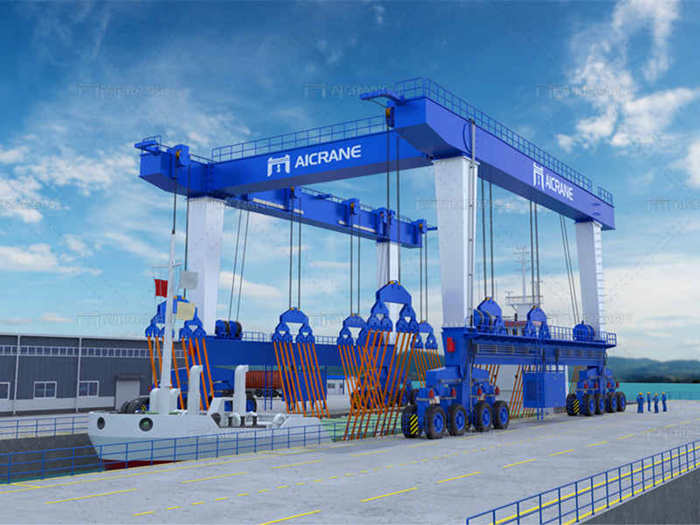A travel lift, also known as a mobile boat hoist or boat lift, is an essential piece of equipment for businesses involved in shipbuilding, marine repairs, and boat storage. While purchasing a travel lift is a valuable investment, its price can be a significant financial consideration. To secure a reasonable travel lift price, effective negotiation is crucial. Below are strategies and actionable tips to help you achieve the best deal.

Understand the Market and Benchmark Prices
Before starting any negotiation, research the current market prices for travel lifts. Familiarize yourself with the typical price ranges based on capacity, features, and manufacturer reputation. Knowing the marine travel lift price trends in the market will give you a benchmark to evaluate offers and avoid overpaying. Key factors to research include:
The lifting capacity (e.g., 50-ton, 100-ton, or more).
Customization options, such as width and lifting height.
Features like remote control systems or eco-friendly designs.
Brand reputation and after-sales support.
Having this information empowers you to make informed decisions and strengthens your position during negotiations.
Identify Your Requirements Clearly
Suppliers are more likely to offer a reasonable boat hoist price when they know your specific needs. Clearly define your requirements to avoid paying for unnecessary features or oversized equipment. Consider:
The maximum weight of the boats or vessels you plan to lift.
The operational environment, such as marina size and conditions.
Portability needs, including whether the lift will operate in multiple locations.
Special features like advanced safety systems or energy-efficient engines.
By presenting your precise needs, you can request a customized quote that reflects only the features you require, avoiding unnecessary expenses.
Compare Offers from Multiple Suppliers
Obtaining quotes from several suppliers ensures you have multiple options to compare. Some suppliers like Aicrane may offer more competitive travel lift prices due to manufacturing efficiencies, proximity to your location, or promotional discounts. Use the quotes to:
Evaluate the base price and additional costs.
Assess the terms of warranties and after-sales support.
Identify hidden charges, such as shipping or installation fees.
Leverage the competing offers to negotiate better terms with your preferred supplier. For example, if Supplier A offers better pricing but Supplier B provides a more trusted brand, you can ask Supplier B to match the pricing.
Negotiate for Value, Not Just Price
Focusing solely on reducing the price can lead to compromising on quality or essential services. Instead, aim for a balance between cost and value. During the negotiation, consider requesting:
Extended warranties or service contracts.
Free or discounted shipping and installation.
Training for your staff on operating the travel lift.
Inclusion of spare parts or accessories in the package.
These added benefits can enhance the value of your purchase, even if the base price remains slightly higher.

Leverage Relationships and Networking
Building a good relationship with the supplier can be a game-changer during negotiations. Suppliers are often more willing to offer discounts or favorable terms to customers they trust and see as long-term partners. To foster a positive relationship:
Communicate clearly and professionally.
Show genuine interest in their product and expertise.
Express openness to future purchases or referrals.
Additionally, networking within the industry can provide valuable insights. Other marina operators or boatyard managers may recommend reputable suppliers known for fair travel lift prices.
Negotiate Based on Payment Terms
Suppliers may offer discounts or incentives based on payment terms. During the negotiation, explore options like:
Bulk discounts for upfront payments.
Deferred payment plans or financing options.
Discounts for purchasing multiple units or related equipment.
Be clear about your budget constraints and seek terms that align with your financial situation. For instance, agreeing to a partial upfront payment with staggered installments might secure a better overall deal.
Highlight Potential for Long-Term Collaboration
Suppliers are more likely to offer competitive pricing if they see the potential for an ongoing partnership. If you plan to expand your operations or require additional equipment in the future, mention this during negotiations. Highlighting future purchase opportunities may encourage the supplier to:
Offer an introductory discount.
Provide loyalty incentives for future transactions.
Prioritize your business for expedited delivery or support.
A win-win relationship benefits both parties and creates opportunities for future collaboration.
Be Open to Used or Refurbished Options
If your budget is tight, consider negotiating for used or refurbished travel lifts. These options often come at a significantly reduced travel lift price while still meeting your operational needs. Ensure the supplier provides:
A thorough inspection report or certification of the equipment’s condition.
Warranty coverage, even if limited.
Transparent details about previous usage and maintenance history.
Discussing refurbished options can provide flexibility during negotiations, allowing you to stay within budget without compromising functionality.
Request a Detailed Quote
A detailed quote is essential to understand the full cost of the travel lift. Request itemized pricing that includes:
Base equipment cost.
Customization fees (if applicable).
Shipping and delivery charges.
Installation and training costs.
Taxes and other applicable fees.
Having a clear breakdown allows you to identify areas where you can negotiate. For example, you might request a waiver of shipping fees or a reduction in installation costs.
Time Your Purchase Strategically
Suppliers may offer better deals during specific times of the year, such as end-of-quarter sales or trade shows. If possible, time your purchase to align with these opportunities. Additionally, inquire about promotional discounts, clearance sales, or limited-time offers. Timing your negotiation strategically can significantly impact the final travel lift price.
Be Willing to Walk Away
While negotiating for the best deal, remain prepared to walk away if the terms don’t align with your expectations. Expressing a willingness to explore other options can motivate the supplier to offer better pricing or additional incentives. Confidence in walking away often demonstrates that you are well-informed and not desperate, strengthening your negotiation position.
Negotiating for a reasonable travel lift price requires preparation, effective communication, and strategic thinking. By understanding your needs, comparing offers, and emphasizing long-term collaboration, you can secure a travel lift that meets your requirements at a fair cost. Remember to focus on value rather than just price, and maintain professional relationships with suppliers to ensure a successful and mutually beneficial transaction.